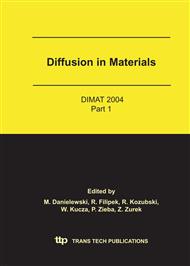p.971
p.979
p.985
p.993
p.998
p.1004
p.1016
p.1022
p.1031
Diffusion of Boron in Silicon and Silicon-Germanium in the Presence of Carbon
Abstract:
Boron diffusion in Si and strained SiGe with and without C was studied. Using gassource molecular beam epitaxy (MBE), B containing epitaxial layers of: (i) Si, (ii) Si containing 0.1% C, (iii) SiGe with 11% Ge and (iv) SiGe with 11% Ge and with a 0.1% C, were grown on substrates. These samples were then rapid thermal annealed (RTA) at 940, 1000 and 1050°C in an O2 ambient. Self-interstitial-, vacancy- and non-injection conditions were achieved by annealing bare, Si3N4- and Si3N4+SiO2-coated surfaces, respectively. Concentration profiles of B, Ge and C were obtained using Secondary-Ion Mass Spectrometry (SIMS). Diffusion coefficients of B in each type of matrix were extracted by computer simulation. We find that B diffusivity is reduced by both Ge and C. The suppression due to C is much larger. In all materials, a substantial enhancement of B diffusion was observed due to self-interstitial injection compared to non-injection conditions. These results indicate that B diffusion in all four types of layers is mediated primarily by interstitialcy type defects.
Info:
Periodical:
Pages:
998-1003
Citation:
Online since:
April 2005
Price:
Сopyright:
© 2005 Trans Tech Publications Ltd. All Rights Reserved
Share:
Citation:


